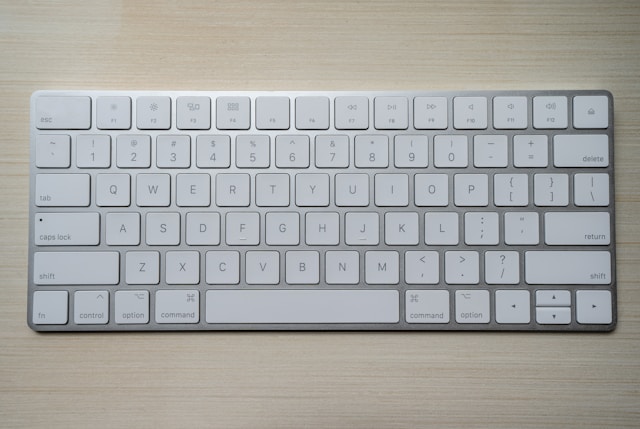In the realm of programming, the keyboard serves as our primary domain, where we wage battles of code creation and refinement over extensive periods. A finely crafted layout can significantly impact our workflow, differentiating between seamless progress and frustrating typing errors. However, with various options such as QWERTY, Dvorak, and Colemak among others, determining the optimal layout often resembles unraveling a complex algorithm.
The QWERTY Layout: An Established and Dominant Player
Enjoying the status of the most prevalently used keyboard layout across the world, QWERTY has carved a name for itself in the annals of the tech world. It reigns supreme in its ubiquity, and is often the default layout on most commercial keyboards. Here’s why QWERTY has remained uncontested:
- Familiarity: The QWERTY keyboard layout is what most people learn to type on. It’s the standard in schools, businesses, and homes worldwide. This widespread adoption helps reduce the learning curve for new programmers, allowing them to focus more on understanding coding principles rather than grappling with an unfamiliar tool;
- Resource Availability: Numerous programming guides, tutorials, and platforms implicitly assume the user’s familiarity with the QWERTY layout. The placement of the keys in coding tutorials corresponds to QWERTY’s format, which makes these resources more intuitive for users accustomed to this layout.
Yet, despite several merits, the QWERTY layout is not without its drawbacks. Some programmers have highlighted potential ergonomic issues associated with frequently used keys in programming languages (for instance, brackets, semicolons). Over time, continuous usage of these keys could potentially result in hand or wrist strain. Therefore, it is important to consider these factors and balance them against individual comfort and ease of use when choosing a keyboard layout for programming.
Embrace Optimized Comfort with Colemak Layout
Catering to the needs of efficiency-focused programmers, Colemak thrives on its ability to streamline keystrokes. It effectively trims down excessive finger travel for a smoother, faster typing experience, helping to alleviate strain.
Key components that cast Colemak in a favourable light include:
- Optimized Key Placement: A noteworthy aspect of Colemak is its thoughtful key allocation. By concentrating the most frequently used keys under the strongest fingers, it fosters efficiency and expedites typing speed;
- Soft Learning Curve for QWERTY Users: The layout retains several key placements from QWERTY, facilitating a less daunting transition for those accustomed to the latter. Thus, QWERTY users considering a switch to a more efficient layout will find Colemak a comfortable starting point;
- Programmer-Friendly Design: The layout’s emphasis on decreasing finger travel distance resonates well with programmers, who often face long coding sessions. Such a design reduces the likelihood of stress injuries, making it a wise choice for programmers.
While Colemak promises multiple benefits, budding users should bear in mind that such a layout switch may initially dent their typing speed. As with any new skill, proficiency in Colemak will require practice and patience. However, the advantages potentially gained in the long run make this temporary hindrance worthwhile.
Discover Enhanced Comfort with the Dvorak Layout
Dvorak has carved a niche for itself in the realm of keyboard layouts with its emphasis on optimized ergonomics. The layout’s design caters to the frequency of letter usage and alternating hand movement, contributing to reduced finger travel and minimized strain.
Dvorak’s prominent offerings result from its innovative structure:
- Targetted Key Positioning: With its methodical allocation of keys based on alphabetical frequency and hand alternation, Dvorak refines the typing process substantially. This layout design ensures that fingers rest on the home row longer, facilitating improved typing speed and accuracy;
- Comfort For Prolonged Typing: The comfort-centric approach of Dvorak enhances user experience during extensive typing sessions, a boon for coders. This potentially leads to an increase in productivity and the overall quality of work;
- Boosted Typing Accuracy: Many programmers have reported an improvement in their typing precision after adapting to Dvorak, further enhancing their coding efficiency.
However, transitioning from QWERTY to Dvorak can be challenging, given the drastic shift in key placement. A steep learning curve may slow down typing speed initially. Yet, with time and practice, users can overcome this barrier and open the doors to a smoother and more comfortable typing experience.
Step into a Coder’s Paradise with the Programmer’s Layout
Tapping into the specific needs of coders, layouts like Programmer’s Dvorak and Norman Layout have been engineered to serve programmers effectively. These layouts have been tailor-made to enhance accessibility to function keys and programming symbols, thereby streamlining the coding process.
Key features that make programmer layouts shine include:
- Prioritized Access to Symbols & Function Keys: With a focus on frequently used coding symbols, these layouts ensure essential programming tools are within easy reach;
- Optimized Placement of Coding Symbols: The thoughtful positioning of brackets, slashes, and other coding symbols helps mitigate hand strain and enhances workflow efficiency;
- Customizability: Given the varied coding practices of individual programmers, these layouts offer a degree of adaptability, allowing users to tweak the layout to suit their specific needs and preferences.
However, adopting the programmer’s layout does not come without its challenges. Prepare for a learning curve as familiarization with the placement of symbols and function keys takes time and practice. Additionally, since these layouts are specialty designs, availability may be limited compared to conventional layouts like QWERTY. But for the avid coder seeking a layout designed with their needs in mind, the adventure into the realm of programmer layouts may prove to be a rewarding journey.
Conclusion
Determining the most suitable keyboard layout for programming isn’t a one-size-fits-all scenario; rather, it hinges on your specific requirements and inclinations. Should you already find comfort in the QWERTY layout and prioritize familiarity, adhering to it may prove most advantageous. Conversely, if you’re receptive to change and value operational efficiency, exploring alternative layouts such as Dvorak or Colemak could be worthwhile, especially noting Programmer Dvorak for its emphasis on programmer-centric symbols.



